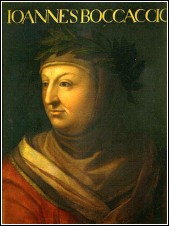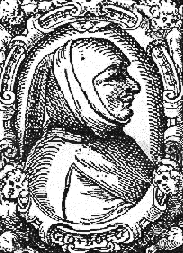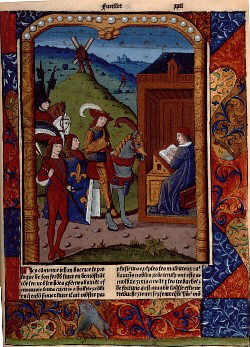

Italian novelist. His father, a merchant from Certaldo and a man of some prominence in Florence, had gone into business in Paris, where Giovanni was born. Shortly afterwards the elder Boccaccio deserted Giannina, the mother of Giovanni, and brought the boy to Florence where he put him to school until he was ten years old, when he took him into business. In 1327 Giovanni travels to Naples with his father, agent of the Bardi Bank. In 1330 Possibly attends lessons of Cino da Pistoia, jurist-poet and friend of Dante and Petrarch, and takes up the study of canon law. However, he gave himself up almost entirely to literature, and became intimately acquainted with some of the most prominent men and women of the court of Anjou. In 1332, Boccaccino moved to Paris. Giovanni, with greater freedom, pursues his humanistic interests in literature as is attested by his first essays in Latin (the Elegia di Costanza and the Allegoria mitologica, both certainly composed before 1334) and his first vernacular poetry. It is supposed that it was in 1334 that he saw for the first time Maria d'Acquino, a married woman and natural daughter of King Robert. She was the inspiration of his earlier works, and the heroine of whom he tells under the name of Fiammetta. In 1340 we find him back in Florence; on the death of his father in 1348, he became the guardian of a younger brother. He held certain public offices in Florence and was entrusted with diplomatic missions to Padua, the Romagna, Avignon, and elsewhere. After 1350 began his friendship with Petrarch, which lasted until the latter's death in 1374. In spite of his advanced age and the political dissensions in Florence which afflicted him sorely, he began, in 1373, his course of lectures in that city on the poems of Dante. He died two years later at his ancestral home in Certaldo.
The earliest, longest, and perhaps the weakest of Boccaccio's works is the Filocolo, written between 1338 and 1340; it is a version of the story, widespread in the Middle Ages, of Floire and Blanchefleur, and contains a curious admixture of pagan myths and Christian legends. In 1339, Giovanni writes the following Latin epistles: The Crepor celsitudinis, dedicated to Carlo, duke of Durazzo; the Mavortis milex, dedicated to Petrarch; the Nereus amphitribus and the Sacre famis, to unidentified friends. Ameto, written in the two following years, is an allegorical novel, telling, among other love-adventures, the sad story of the life of Boccaccio's mother. L'Amorosa Visione, in praise of love, dates from about the year 1342, and consists of fifty cantos in terzine, and the initial letters of the verses form an acrostic of two sonnets and one ballata. Teseide, probably of the year 1341, is the first artistic work in ottava rima. It contains many imitations of antiquity, and was widely read up to the sixteenth century. Tasso thought so highly of it that he annotated it. The subject is the story of Palemon and Arcite which Chaucer used for his Knight's Tale.
Il Filostrato, written in the same year and likewise in ottava rima, tells of the love of Troilus for Chryseis. The subject may have been suggested to Boccaccio by his adventure with Fiammetta. Ninfale Fiesolano, a short poem in ottava rima, is the best, in style and invention, of the minor works of Boccaccio. Il Fiammetta is one of the best written of his works, the most original and the most personal. Panfilo, the hero and lover of Fiammetta, is supposed to represent Boccaccio himself. Il Corbaccio (1354) has had its admirers, but it is one of the most bitter and indecent satires ever written against woman. Il Vita di Dante (about 1364), based chiefly on information furnished by contemporaries of Dante, remains one of the best lives of the poet. "Commento sopra la Commedia", the fruit of his public lectures on Dante, was planned to be a colossal work, but Boccaccio had commented only upon the first seventeen cantos when it was broken off by his death.
In 1350, Boccacio first met with Petrarch in Florence. In this year he baegan work on the Genealogia deorum gentilium, a work which was not finished until 1374. In 1351 Boccaccio moved to Padua where he again met Petrarch. He joined the court of Louis of Bavaria as ambassador from the city-state of Florence. The first draft of the Trattatello in laude di Dante reached completion. Boccaccio returnwed to Naples in 1355. This is the earliest feasible date of the second draft of the Amorosa visione which is definitively completed in 1360. He began work on the De casibus virorum illustrium and the De montibus, silvis, fontibus et de nominibus maris liber which were finished respectively in 1363 and 1364. Boccaccio probably received the Invective contra medicum İfrom Petrarch in 1357 in Ravenna. He had his third meeting with Petrarch in 1359, this time in Milan. Boccaccio was that year named ambassador to Lombardy, perhaps at the court of Bernabò Visconti.
In 1360 there appeared the first complete version of the De casibus and first abridged edition of the Trattatello. Pope Innocent VI in that year inducted Boccaccio into the clergy. In an aborted coup d'état in Florence, several of Boccaccio's friends and acquaintances were implicated, some of whom (including Niccolò di Bartolo Del Buono and others) were subsequently executed; for the next four years, Boccaccio received no further official Florentine appointments. Boccaccio withdrew to Certaldo in 1361 and began work on De mulieribus claris. Howvere, some time in 1361-62 he returned, for unidentified reasons, to Ravenna. Here he collected information regarding San Pier Damiani for Petrarch who was working on De vita solitaria. In 1362, he completed the definitive version of the De mulieribus. In 1362 he began composition of Vita sanctissimi patris Petri Damiani.
In 1363, following a serious crisis of faith, Boccaccio dedicated himself exclusively to spiritual pursuits. He traveled again to Naples but stayed there only for a relatively short period on account of his lukewarm reception. After returning to Florence, he went to Padua to see Petrarch but eventually met him in Venice whither the latter had moved. In July Boccaccio proceded to Certaldo. He also brought to its conclusion the final version of the Genealogie.
During 1364 and 1365 Boccaccio engaged in an enduring epistolary debate with Petrarch on compositions in the vernacular. In 1365 he traveled to the papal court of Urban V in Avignon as Florentine ambassador. In the same year he composed the Corbaccio. and dedicated himself to the second abridged edition of the Trattatello. In 1367, he visited Venice, where he did not have the opportunity to meet with Petrarch but did find Petrarch's daughter and son-in-law. Boccaccio was in that year appointed ambassador to the papal court in Rome. In 1368, however, in Padua he met with Petrarch around whom many intellectuals and literary figures had gathered.

In 1369-70 Boccaccio oversaw the publication of the Buccolicum carmen, and, after a last trip to Naples in 1370-71 he retired to Certaldo. By 1372 Boccaccio was increasingly troubled by obesity, and also by a form of dropsy which impeded his movement, together with attacks of scabies and high fevers. 1373 saw the dedication of the definitive version of the De casibus to Mainardo Cavalcanti, and the continuation of revisions of the Genealogie. Boccaccio was entrusted by Florence during this year to conduct a series of readings and lectures on the Divina Commedia.
Boccaccio returned to Certaldo in 1374 in a state of financial troubles and ailing health, where he learned of Petrarch's death. The passing of his long-time friend inspired the last sonnet of his mature poems. He continued work on the Genealogie.
Boccaccio died on December 21, 1375, at his home in Certaldo.
Boccaccio shares with Petrarch the honor of being the earliest humanist. In their time there were not a dozen men in Italy who could read the works of the Greek authors in the original. Boccaccio had to support at his house for three years a teacher of Greek, with whom he read the poems of Homer. Of Boccaccio's Latin works the following are to be mentioned: De genealogiis deorum gentilium (between 1350 and 1360), but published first in 1373. This dictionary of classical mythology shows remarkably wide reading and a very good understanding of the works of the ancients and, in spite of errors which it could not but contain, it continued for several hundred years to be an authority for the student of classical antiquity. Two biographical works: De claris mulieribus and De casibus virorum illustrium (between 1357 and 1363) are of little interest, since they tell of men and women of ancient times and but rarely of the author's contemporaries. There remain the Latin letters and eclogues, which are not of much worth, and eight or ten unimportant works which have been ascribed to Boccaccio.
The book with which Boccaccio's name is inseparably linked is the Decameron, which was finished in 1353, but part of which had probably been written before the Black Death reached its height in 1348. The Decameron opens with a masterly description of the terrors of the pest, and we are then introduced to a gay company of seven ladies and three young men who have come together at a villa outside Naples to while away the time and to escape the epidemic. Each in turn presides for a day over the company and on each of the ten days each of the company tells a story, so that at the end one hundred stories have been told. It is difficult to say whether such a company as Boccaccio describes ever met. At all events, he says that he has taken pains to conceal the real names of the persons mentioned in the stories. There are reasons to believe, however, that Fiammetta is the same lady to whom Boccaccio has given that name in other works, while Dioneo may well represent Boccaccio himself.
The great charm of the Decameron lies in the wonderful richness and variety of the adventures which he relates, in the many types of character and the close analysis of all shades of feeling and passion, from the basest to the noblest. The style is now Ciceronian, now that of the everyday speech of Florence. The sentence-structure is, to be sure, often involved and inverted, and it often requires several readings to enjoy a full understanding of the phrase. Boccaccio found the germs of his novelle in other literatures, in historic events, and in tradition, but, like Shakespeare, whatever he borrowed he made his own and living, by placing the adventures in the lives of his contemporaries. Boccaccio was a steadfast friend, a son who felt tenderly for his mother and never forgave his father for having abandoned her. He speaks with affection of his daughters who had died in childhood; it is not known who their mother was. He was a scholar of the first rank for his time, a man of independent character, and a good patriot.
No autograph copy of the Decameron exists, but there are three manuscript copies dating from the fourteenth century. The first edition was not printed until 1470 in Venice, and since then numerous editions have appeared, but there is as yet no critical edition. Of the modern editions P. Fanfani's is convenient (2 vols., reprinted Florence, 1890). An excellent school edition of selected novelle with notes is that of R. Fornaciari (Florence, 1890). The Decameron has been translated into nearly every European tongue; the first complete English edition dates from 1620.

"The author writing his works", from: Giovanni Boccaccio, De casibus virorum illustrium /De la Ruine des Nobles hommes et femmes, Paris Nov. 4, 1494, Printerer: Antoine Verard.